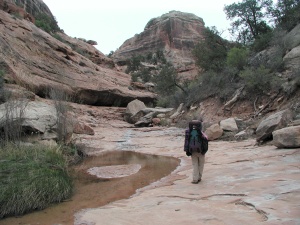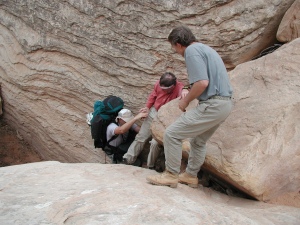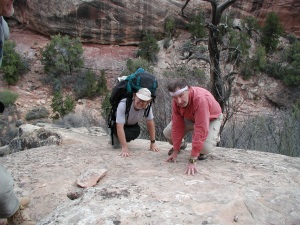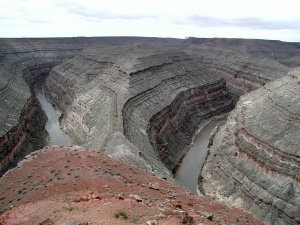Grand Gulch 2001
Collins to Todie - Opus 2
Exit at Todie
Saturday, April 21
 I was awake way before 6 am, and I wasn't even running the shuttle. One of the phenomena that one experiences on a still night camped across the canyon from a huge concave wall is that the wall acts like a giant sound amplifier. Every snore, every cough, every zipper pulled is shared with the entire party. Ray was up and breaking camp, so I got up and encouraged him to wait for John until the appointed hour. The rest of us were up by 6:30, and took a leisurely approach to packing up, since it was either wait at camp or wait for the shuttle vehicle on top. The morning was ominous, in a way. Thick, dark clouds seemed to signal an approaching front. (We would learn later that much of the territory we had been hiking in got snow by evening.) Susie and I rolled out of camp at 8:01. George had left with Barbara a half hour earlier, and Lance, Cora, and Andy seemed but a few minutes from leaving.
I was awake way before 6 am, and I wasn't even running the shuttle. One of the phenomena that one experiences on a still night camped across the canyon from a huge concave wall is that the wall acts like a giant sound amplifier. Every snore, every cough, every zipper pulled is shared with the entire party. Ray was up and breaking camp, so I got up and encouraged him to wait for John until the appointed hour. The rest of us were up by 6:30, and took a leisurely approach to packing up, since it was either wait at camp or wait for the shuttle vehicle on top. The morning was ominous, in a way. Thick, dark clouds seemed to signal an approaching front. (We would learn later that much of the territory we had been hiking in got snow by evening.) Susie and I rolled out of camp at 8:01. George had left with Barbara a half hour earlier, and Lance, Cora, and Andy seemed but a few minutes from leaving.
The floor of the canyon for the first quarter mile above camp is deceptively smooth, but then it roughens up considerably. There are huge boulders to negotiate, and having a full, albeit lighter, pack only heightens the challenge. We could see lots of ruins as we would stop for a breather. Todie seems to have the greatest concentration of ruins per mile of any canyon I have been in. It is not fast hiking, as one is continually figuring out how to scramble up to the next level. There were two or three pour-offs that have to be negotiated to the right.  In one spot, it was necessary for us to remove our packs, and hoist them to the next level. One of the most interesting experiences was seeing an old stock tank buried in a lot of sand and rubble, wedged between two huge boulders. When you hike in this country, you understand cognitively that the terrain can change in the course of one flash flood. But there is always the sense that geologic time really still prevails. To see a huge tank, clearly built in the last 100 years or so, wedged down beneath giant boulders, knowing that a flood of biblical proportions could have occurred sometime so recently is a good reminder that in these canyons, change can happen in eons or minutes. One doesn't want to be around when the change is happening quickly.
In one spot, it was necessary for us to remove our packs, and hoist them to the next level. One of the most interesting experiences was seeing an old stock tank buried in a lot of sand and rubble, wedged between two huge boulders. When you hike in this country, you understand cognitively that the terrain can change in the course of one flash flood. But there is always the sense that geologic time really still prevails. To see a huge tank, clearly built in the last 100 years or so, wedged down beneath giant boulders, knowing that a flood of biblical proportions could have occurred sometime so recently is a good reminder that in these canyons, change can happen in eons or minutes. One doesn't want to be around when the change is happening quickly.
 The floor of the canyon now seemed more like a mountain creek valley than a floor. It gains a lot of elevation quickly. We came to the spot where the route hangs a sharp right at a cleft in the right wall of the canyon, and begins its exit. At this point, the climbing gets really steep. Not dangerous, and with little exposure, but it feels like you are on an elevator. As we neared the top, we finally reached what I regard as "the crux." It is probably the reason why rangers discourage backpackers from entering the canyon via Todie. You get to a large boulder, the size of a house room, and the path clearly, with the aid of a couple of fortuitously present rocks, climbs up on the side of this boulder. One must take great care doing the friction walk up the slab of rock because it's a 50 foot drop to your right. (If you were coming down the trail, the critical "enabling" rocks would be out of view, and it would appear that the route just drops off into the abyss. In addition, hiking down this slab would not feel as comfortable as scrambling up it. I would recommend that if you are going down this route, take off your backpack and very carefully work your way down the slab until you can look over and find the spot where the rocks help you get off the slab.) I went up first, took off my pack in a stable area, and then went back to provide a helping hand. It is possible to do it without assistance, but there are a couple of steps in the friction walk that you need to make quickly. Of course, all these experienced canyon hikers had no trouble, but it was the trickiest thing we had encountered all week.
The floor of the canyon now seemed more like a mountain creek valley than a floor. It gains a lot of elevation quickly. We came to the spot where the route hangs a sharp right at a cleft in the right wall of the canyon, and begins its exit. At this point, the climbing gets really steep. Not dangerous, and with little exposure, but it feels like you are on an elevator. As we neared the top, we finally reached what I regard as "the crux." It is probably the reason why rangers discourage backpackers from entering the canyon via Todie. You get to a large boulder, the size of a house room, and the path clearly, with the aid of a couple of fortuitously present rocks, climbs up on the side of this boulder. One must take great care doing the friction walk up the slab of rock because it's a 50 foot drop to your right. (If you were coming down the trail, the critical "enabling" rocks would be out of view, and it would appear that the route just drops off into the abyss. In addition, hiking down this slab would not feel as comfortable as scrambling up it. I would recommend that if you are going down this route, take off your backpack and very carefully work your way down the slab until you can look over and find the spot where the rocks help you get off the slab.) I went up first, took off my pack in a stable area, and then went back to provide a helping hand. It is possible to do it without assistance, but there are a couple of steps in the friction walk that you need to make quickly. Of course, all these experienced canyon hikers had no trouble, but it was the trickiest thing we had encountered all week.
 A couple more steep stretches, and a squeeze or two through some brush, a hop across a big crack and we were on top. It had taken us exactly 2 hours to make it the one mile from camp to the top. (Ray and John did it in 75 minutes, so it can be done more quickly.) Everyone took some time to marvel at the view, take a leak, and give thanks that we were not going in on this day: the clouds to the west were getting darker. We ran into a couple that was backpacking into the canyon on this route, but their demeanor and gear suggested that there were real canyon rats, and would have little difficulty getting in. From where the trail tops out, it is a bit over a half-mile of easy strolling to the parking area for the trailhead. By the time we arrived, Ray and John were back with both vehicles, and we were already ahead of schedule. We loaded up, settled on a stop at the Goosenecks of the San Juan, since Cora had never seen them. It is always an impressive sight, no matter how many times you have seen them. Lunch was the traditional Navajo Tacos in the San Juan Café in Mexican Hat. We rolled out of there at 1:15 pm, and were back in Albuquerque by 6 pm, in time for dinner.
A couple more steep stretches, and a squeeze or two through some brush, a hop across a big crack and we were on top. It had taken us exactly 2 hours to make it the one mile from camp to the top. (Ray and John did it in 75 minutes, so it can be done more quickly.) Everyone took some time to marvel at the view, take a leak, and give thanks that we were not going in on this day: the clouds to the west were getting darker. We ran into a couple that was backpacking into the canyon on this route, but their demeanor and gear suggested that there were real canyon rats, and would have little difficulty getting in. From where the trail tops out, it is a bit over a half-mile of easy strolling to the parking area for the trailhead. By the time we arrived, Ray and John were back with both vehicles, and we were already ahead of schedule. We loaded up, settled on a stop at the Goosenecks of the San Juan, since Cora had never seen them. It is always an impressive sight, no matter how many times you have seen them. Lunch was the traditional Navajo Tacos in the San Juan Café in Mexican Hat. We rolled out of there at 1:15 pm, and were back in Albuquerque by 6 pm, in time for dinner.
As George would say, "Is this a great country, or what?"
© Roger A. Jenkins, 2001
